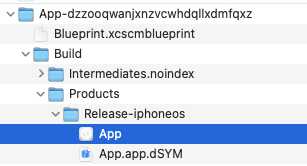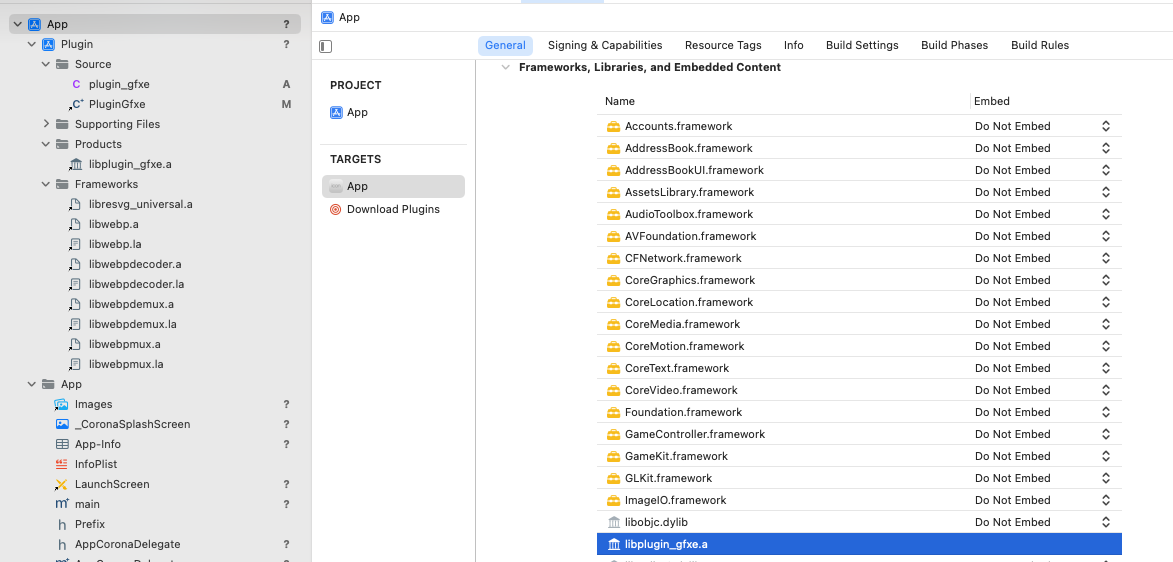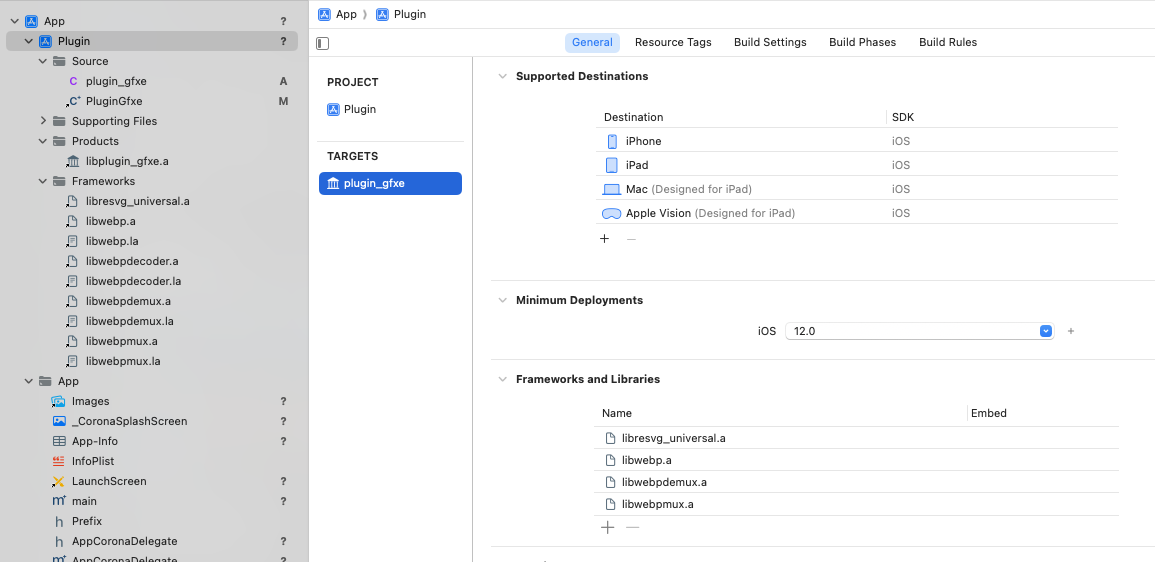Plugin
GitHub/Graphics-Extensions-for-Solar2D/package-plugin
The following plugins are built for iOS/macOs by kwiksher
plugin_movie
plugin_gfxe
refer to @workspace/Solar2D-plugin_movie_kwiksher about the folder structure, can you setup new folders for poring @workspace/Graphics-Extensions-for-Solar2D to ios/mac?
mac_template
it is a skelton plugin for testing
- build.sh
- plugin_gfxe.lua
- shared/SimulatorPluginLibrary.cpp
dependencies
resvg-0.40.0
iOS:
ios/build_resvg_ios.shmacOS:
mac/build_resvg_mac.shRUST_DIR="$PROJECT_DIR/dependencies/resvg-0.40.0" OUTPUT_DIR="$SCRIPT_DIR/lib" # For arm64 rustup target add aarch64-apple-ios cargo build --release --target aarch64-apple-ios --manifest-path "$RUST_DIR/crates/c-api/Cargo.toml" # For simulator (x86_64) rustup target add x86_64-apple-ios cargo build --release --target x86_64-apple-ios --manifest-path "$RUST_DIR/crates/c-api/Cargo.toml" # Create universal binary lipo -create \ "$RUST_DIR/target/aarch64-apple-ios/release/libresvg_capi.a" \ "$RUST_DIR/target/x86_64-apple-ios/release/libresvg_capi.a" \ -output "$OUTPUT_DIR/libresvg_universal.a"
libdebp-1.2.3
iOS
cd dependencies/libwebp-1.2.3iosbuild.sh is modified for only iPhoneOS-V7-arm64
PLATFORMS="iPhoneOS-V7-arm64"
now you can run
chmod +x iosbuild.sh
./iosbild.sh
mv iosbuild build_ios
mv build_ios/iPhoneOS-18.2-aarch64/lib/*.a ../ios/libOutput: ios/plugin/build/plugin_gfxe/libplugin_gfxe.a
macOS
README_gemini.md
xcode-select --install brew install cmakecd build_x86_64 cmake -DCMAKE_OSX_ARCHITECTURES="x86_64" .. make -j4cd build_arm64 cmake -DCMAKE_OSX_ARCHITECTURES="arm64" .. make -j4mkdir universal_libwebp cd universal_libwebp lipo ../build_arm64/libexampleutil.a ../build_x86_64/libexampleutil.a -create -output libexampleutil.a lipo ../build_arm64/libextras.a ../build_x86_64/libextras.a -create -output libextras.a lipo ../build_arm64/libimagedec.a ../build_x86_64/libimagedec.a -create -output libimagedec.a lipo ../build_arm64/libimageenc.a ../build_x86_64/libimageenc.a -create -output libimageenc.a lipo ../build_arm64/libimageioutil.a ../build_x86_64/libimageioutil.a -create -output libimageioutil.a lipo ../build_arm64/libwebp.a ../build_x86_64/libwebp.a -create -output libwebp.a lipo ../build_arm64/libwebpdecoder.a ../build_x86_64/libwebpdecoder.a -create -output libwebpdecoder.a lipo ../build_arm64/libwebpdemux.a ../build_x86_64/libwebpdemux.a -create -output libwebpdemux.a lipo ../build_arm64/libwebpmux.a ../build_x86_64/libwebpmux.a -create -output libwebpmux.acopy dependences/universal_libwebp/*.a mac/lib/ copy dependences/universal_libwebp/*.a ios/lib/
ios/mac
build plugin_gfxe
chmod +x build.sh
./build.shOutput: mac/plugin_gfxe.dylib
cp plugin_gfxe.dylib ~/Library/Application Support/Corona/Simulator/PluginsiOS App
Output: ~/Library/Developer/Xcode/DerivedData/App-dzzooqwanjxnzvcwhdqllxdmfqxz/Build/Products


XCode Linking libraries
App/libplugin_gfxe.a

Plugin/

- ibresvg_universal.a - ibwebp.a - ~~ibwebpdecoder.a~~ - ibwebpdemux.a - libwebpmux.a
Simulator
you may comment out the plugin gfxe in build.settings for testring
Corona/main.lua
local gfxe = require('plugin.gfxe')
local asset_reader = require('plugin.AssetReader')
local font
local platform = system.getInfo('platform')
if platform == 'android' then
font = asset_reader.Read('fonts/Inconsolata-Regular.ttf')
else
local file = io.open(system.pathForFile('fonts/Inconsolata-Regular.ttf'), 'rb')
font = file:read('*a')
file:close()
end
-------------------------------------------------------------------
local svg1 = gfxe.newScalableImage(
{
filename = 'images/h350.svg'
},
{
fontData = font,
fontFamily = 'Inconsolata'
}
)
svg1.x, svg1.y = display.contentCenterX, display.contentCenterYEmbedding Lua Bytecode in a C Plugin for Solar2D
To embed Lua bytecode in your C plugin, you’ll need to convert your plugin_library.lua to bytecode and then include it as a static resource in your C code. Here’s a step-by-step guide:
Step 1: Convert Lua to Bytecode
First, use the luac compiler (comes with Lua) to generate bytecode:
luac -o plugin_library.luac -s plugin_library.luaThe -s option strips debug information to reduce size.
Step 2: Convert Bytecode to C Array
Convert the .luac file to a C byte array using a hex dump tool:
xxd -i plugin_library.luac > plugin_library_bytecode.hThis creates a header file containing something like:
unsigned char plugin_library_luac[] = {
0x1b, 0x4c, 0x75, 0x61, 0x53, 0x00, 0x19, 0x93, 0x0d, 0x0a, 0x1a, 0x0a,
// ... more byte values ...
};
unsigned int plugin_library_luac_len = 123;Step 3: Load the Bytecode in Your C Plugin
Modify your plugin_library.c to load the embedded bytecode:
#include "lua.h"
#include "lauxlib.h"
#include "lualib.h"
#include "plugin_library_bytecode.h" // The generated header
static int luaopen_plugin_library(lua_State *L) {
// Load the bytecode
if (luaL_loadbuffer(L, (const char*)plugin_library_luac,
plugin_library_luac_len, "plugin_library.lua") != LUA_OK) {
return lua_error(L); // Propagate error
}
// Run the chunk to initialize the library
if (lua_pcall(L, 0, 1, 0) != LUA_OK) {
return lua_error(L);
}
// The library table is now on top of the stack
return 1;
}Step 4: Building the Plugin
Compile with the embedded bytecode:
gcc -shared -fPIC -o plugin_library.so plugin_library.c -I/path/to/lua/headersAlternative Approach: Direct String Embedding
If you prefer not to generate a separate header file, you can embed the bytecode directly:
// In plugin_library.c
static const unsigned char plugin_library_bytecode[] = {
0x1b, 0x4c, 0x75, 0x61, 0x53, 0x00, 0x19, 0x93, 0x0d, 0x0a, 0x1a, 0x0a,
// ... more byte values ...
};
static const size_t plugin_library_bytecode_len = sizeof(plugin_library_bytecode);
// Then use luaL_loadbuffer as shown above
Important Considerations
- Lua Version Compatibility: Ensure the bytecode matches the Lua version used by Solar2D
- Bytecode Security: Don’t load untrusted bytecode as it could execute arbitrary code
- Debugging: Consider keeping debug info during development (
luacwithout-s) - Solar2D Specifics: Solar2D may have additional requirements for plugin initialization
Would you like me to provide more details about any specific part of this process?